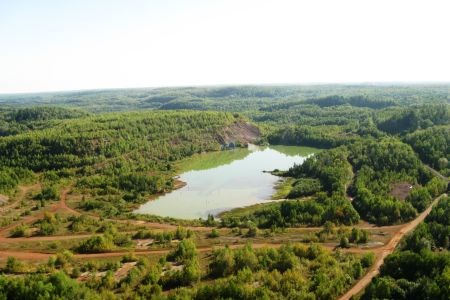A murky plan by the provincial government to rehabilitate and re-open a former northwestern Ontario open pit mine for industrial use has a Thunder Bay iron ore miner pondering whether to move his processing operation elsewhere.
Henry Wetelainen, president of Bending Lake Iron Group, came away confused from the Aug. 5 announcement that the Ontario government has accepted business proposals from his company and gold miner Brett Resources.
But the Ministry of Natural Resources said the companies’ proposals are subject to several conditions, including a full environmental assessment at the 5,200-hectare brownfield property, before any development takes place.
"The problem we have is that there’s no guarantee of tenure when we go through the process," said Wetelainen, who has been pursuing access to the property for four years.
"We want to see them lay out exactly what is the process."
If the environmental assessment becomes too onerous, too lengthy and too costly, Wetelainen said he may locate his processing operation elsewhere.
Wetelainen’s company wants to ship iron ore mined from its Bending Lake deposit, near Ignace, to the Steep Rock site by pipeline for processing into a high-quality iron nugget for the U.S. steel industry. Brett (now owned by Osisko Mining Corp.) wants to use one of the property’s multiple pits as a tailings basin for its nearby Hammond Reef gold mine project. Bending Lake Iron’s project, valued at $900 million, would create 700 construction jobs over a two-year period as well as 300 permanent jobs.
The property is very environmentally sensitive and there are several mitigation and water quality issues to address, such as acid mine drainage from the old mining process.
Atikokan leaders have long wanted to breathe new industrial life into the abandoned open pit, which stopped iron ore production in 1979. Since the brownfield site is close to road, rail, power and natural gas connections, it’s been considered an almost turnkey site for industrial development for many years.
Mayor Dennis Brown was elated with the province’s news which potentially can clear the way to create hundreds of mining and processing jobs in the community of 3,300.
"These two projects are the Ring of Fire for the area west of Thunder Bay," said Brown, comparing this future development to the massive mineral find in the James Bay region.
The Steep Rock Mine was the main employer in Atikokan when it operated from 1944 to 1979. It employed 1,500 at its peak.
It took a major feat of engineering to build. Steep Rock Lake was drained during the Second World War to access the iron ore. To stop the flow of water into the lake, the area’s watershed was reconfigured through a network of dams and tunnels to divert the Seine River. Since the site reverted to the Crown in 1988, the province has spent close to $7 million to maintain these structures.
Allan Willcocks, the MNR’s regional director n Thunder Bay, who is overseeing the land management planning for Steep Rock, was on vacation in August and unavailable for comment.
Ministry spokeswoman Kathryn Lyzun said these business proposals must meet "stringent environmental standards" before any provincial approvals are given. In an e-mail interview with Northern Ontario Business, she said the companies will be required to file their development plans and show how their projects will support the site’s rehabilitation.
An environmental assessment process could take one to three years before any construction occurs.
Lyzun noted the province will consider other "complementary" industrial and commercial business proposals for the property.
A third company, Cassandra Power, wanted to use a pit as a reservoir to store and pump water to generate power.
Lyzun said because MNR’s waterpower site release policy is under review, the ministry "is not accepting applications for waterpower development at this time."
When asked if his company would be willing to maintain the dams, Wetelainen hesitated and said his engineering team was determining "whether we’re going to stay and take the opportunity to redevelop that brownfield or go with our second option to redevelop a greenfield site up in Bending (Lake), north of the CP (Canadian Pacific Railway) line."
His company is considering two greenfield sites about 20 kilometres north of their deposit to place the processing plant where there is rail access, power and natural gas connections.
Relocating to a site near Ignace would save them $30 million in pipeline costs.
Wetelainen said they may make a final decision as early as mid-September depending on the outcome of their discussions with the MNR.
"If I start an environmental assessment on a greenfield site, I know the process. I know exactly the steps I gotta go through and I know in the end what I get."
Should a full-blown environment assessment last three years and cost millions of dollars, Wetelainen isn’t confident his shareholders would want to place the processing at Atikokan.
Getting access to Steep Rock would allow the company to complete its financing to purchasing iron processing equipment and start construction.
Many American steel companies have approached them looking to invest in the project or take some of the production.
Finding a new use for Steep Rock is resonating with the provincial politicians who heralded theirgovernment’s announcement as a new beginning for Atikokan and Steep Rock.
"The status of this former mine site has long been a concern to those who live in Atikokan," said Natural Resources Minister Linda Jeffrey in a statement. "My ministry is committed to working closely with the local community on how best to support the long-term rehabilitation of the site and at the same time build economic stability."
Northern Development, Mines and Forestry Minister Michael Gravelle said the site’s rehabilitation is essential to the area’s environment.
"The government of Ontario is delighted to have two (industry) partners willing to invest in the region and help reduce environmental risks at the Steep Rock site."




